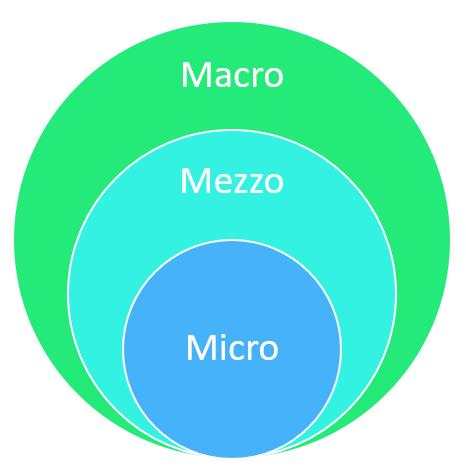2024 Guide: The 3 Main Levels of Social Work
2024 Job Aid: Understanding the Distinction Between Macro, Mezzo, Micro Social Work
Social work at all levels can have a significant positive impact on individuals and groups. The main difference between micro, macro, and mezzo social work is the scope of this social worker guide.
The mission of those in the social work profession is the same no matter their area of expertise or level of social work engagement. That mission is to improve the lives of people by addressing their basic needs and to promote social justice and dignity for communities and individuals. These needs are often related to their social environment and individual emotional and mental health.
How social workers address those needs can be categorized into three different levels of social work – Macro, Mezzo, Micro (also known as Macro, Meso, Micro social work).

Micro, Mezzo and Macro Social Work
When considering entering the social work profession, it’s good to know the three different levels of social workers. Some practitioners might find they enjoy one over another. In finding your perfect fit, working in mezzo, micro and macro social work at different times can also give you a better understanding of how each of these broad categories is interconnected.
Have you been looking for an easy-to-read article that explains micro, macro, and mezzo social work? Read on to learn the distinctions between these different levels of social work and find examples of each one.
See Also: Children Depression and Anxiety Assessment
Table of Contents: Mezzo, Macro, Micro Social Work
Keep on scrolling down this page to read each section or click any link below to go directly to that section.
- What Are the 3 Levels of Social Work?
- What Are Examples of Micro Social Work?
- What Are Examples of Mezzo Social Work?
- What Are Examples of Macro Social Work?
- How Do Macro, Mezzo, and Micro Social Work Interconnect?
- Conclusion | Job Aid for Micro, Mezzo, Macro Social Work
- FAQ | Mezzo, Micro, Macro Social Work
Don’t Miss: Social Worker Job Description, Responsibilities & Duties Guide
Is there a micro macro mezzo technique that has provided great value to you that we can include in this guide for others to leverage? Or do you have feedback on a best micro and macro practice in social work that you would like to share with other social work practitioners. If so, contact the Social Work Portal Team.
Overview: What Are the 3 Levels of Social Work?
All social work is focused on individuals, but it often takes various levels of social services activity to achieve the end goal of improving a person’s life.
For example, say that a non-profit organization notices an increase in opioid addiction in the clients they are seeing at a food pantry. A social worker on staff may be helping at the micro level by referring these individuals to a rehabilitation program.
But, say that non-profit found that the available program was overwhelmed. They may choose to serve the entire community by opening their own substance abuse addiction treatment center. In this case, a mezzo-level social worker would help to plan that program to match an identified need in their community.
That program becomes a success, and a macro-level social worker realizes that it could be scaled up to work throughout the state. They research, plan, and lobby lawmakers and get funding to implement that program state-wide.
Once that happens, micro, mezzo social workers in other areas will begin implementing that program throughout a community and to assist individual clients.
This is an example of how various types of social workers can help those with substance abuse addictions but at three different levels.
The three main levels of social work are:
- Micro: Micro social work is done at an individual level, one-on-one with a patient/client, their family, or with a small group.
- Mezzo (or Meso): Mezzo social work is about helping larger groups at a community, organization, or institutional level.
- Macro: Macro social work is typically done indirectly through policy development, research, etc. The focus is to help larger groups of people, for example, at the county, state, province, or country level.
Now that we’ve covered the three micro mezzo and macro levels social work need to be aware of, it is time to do a deep dive.
Related: Social Work Assessment with Templates & Samples
Do you have questions about micro, mezzo, and macro levels social work? If so, contact the Social Work Portal Team.
What Are Examples of Micro Social Work?
Micro social work means working with individuals and small groups – the tightest scope of social work. This can include providing psychotherapy services, where you are assessing individuals, creating treatment plans, and working with them individually. Group therapy would also be considered at the micro-level.
A Foster Care social worker would be considered to be practicing micro social work because they are working directly with children and families to ensure the safety and well-being of the child.
Other examples of micro social work would include:
- School social workers that are working with at-risk students on individual education plans
- Social workers that offer couples and family counseling.
Popular Article: What You Need to Know About the HIPAA Form for Patients to Release Medical Information
Do you have any questions or feedback about this article on social work micro, mezzo, and macro levels and micro and macro practice in social work? If so, contact the Social Work Portal Team.
What Are Examples of Mezzo Social Work?
Mezzo social work expands the scope of who is being helped by social services programs and services. Social workers at the mezzo level are considering factors that impact individuals in a larger group than micro social work. Such as residents at a shelter or clients served by a hospital or non-profit agency.
A site manager overseeing a child’s mentorship program and making decisions on how to improve the lives of all the children coming through their doors would be considered doing mezzo social work.
Two more examples of mezzo social work would be as follows:
- A community health social worker coordinating a program to provide nutritional meals to underprivileged seniors in the community.
- An educational social worker conducting a training program for school district teachers about working with disabled students.
Read More: What Are the Different Types of Social Workers
Do you have any questions about the different levels of social workers or how to identify a micro, macro, and meso level in social work? Contact the Social Work Portal Team.
What Are Examples of Macro Social Work?
Many indirect social work services are provided at the macro level. Macro social work does not typically include working with individuals or groups directly, however, macro-level social workers can still have a profound impact on people and groups.
Macro-level social workers study large groups or populations to identify basic needs that can be served through social services, as well as systematic causes of social injustice. Those working at the macro level are typically working in positions of research, advocacy, program implementation, and community organization or development.
The groups that macro level social work involves is the largest scope – which could include a country, state, province, or organizations serving multiple geographic areas.
Some examples of macro social work include:
- A social worker studying the impacts of mobile devices on child depression that publishes their findings for other social workers and organizations (and those they serve) to benefit from.
- An international social worker that has developed a program to be implemented in multiple areas to improve access to health care for women and girls.
Related: How to Get a Social Worker for Help with Emotional, Physical, or Mental Needs
Is there a mezzo macro micro social work process and technique that has provided great value to you that we can include in this guide for others to leverage? If so, contact the Social Work Portal Team. Also, does your organization have a better definition of exo level social work? If so, let us know.
How Do Macro, Mezzo, and Micro Social Work Interconnect?
Micro, mezzo, and macro practice in social work are interconnected and interdependent in the sense that they all play a crucial role in promoting social justice and positive change in society. The work at each level – Micro, Mezzo, Macro – impacts and is impacted by the work at other levels. This creates a dynamic and interconnected system of social support and intervention.
At the macro level, social workers create and implement policies and programs that address larger societal issues. These policies and programs trickle down and affect the work that takes place at the mezzo and micro levels.
For example, take the example of the social worker at the macro level that publishes research on the impact of devices on childhood depression. The findings and guidance in that research paper could be used at the mezzo and micro levels to help children in communities or in individual therapy. That’s one example of how micro, mezzo, and macro social work practice interconnect.

Micro, Mezzo, and Macro Social Work
At the mezzo level, social workers work with smaller communities and groups to address issues that may not be addressed with macro social work. This level of intervention often provides the bridge between the broader policies and programs created at the macro level and the individual needs and experiences of those in the community.
At the micro level, social workers can directly implement policies created at the macro and mezzo levels with individuals to address their specific needs. Micro social work is the one that can most directly see the tangible benefits of a program or policy on the individual it was meant to help.
When working in mezzo, micro, and macro practice in social work, you may run across the term exo level social work. This is a term that describes identifying factors not in an individual’s control that impact their social and mental well-being. Such as when schools switched to online learning during the pandemic, it was a circumstance students could not control, but one that directly impacted their well-being.
Looking at the complete social environment of individuals and groups is a necessity, no matter which level of social work you’re practicing – micro, mezzo, macro.
Don’t Miss: Social Work Evaluation Methods for Social Workers
Is there a great macro mezzo micro social work technique that has provided great value to you that we can include in this guide for others to leverage? If so, contact the Social Work Portal Team.
Conclusion | Job Aid for Micro, Mezzo, Macro Social Work
Together, micro, mezzo, macro social work creates a comprehensive system of support and intervention that promotes social justice and well-being for all individuals and communities. Each level of intervention is necessary for creating a just and equitable society and promoting social, mental, and emotional well-being.
Because it’s important for social workers at all levels to work collaboratively to create positive and lasting change, it’s helpful to understand the micro, macro, mezzo social work connection.
Social workers that have experience at all levels of social work will have a more robust understanding of how these different scopes of social service support interconnect. This can foster a more successful social work practice.
We hope this guide on the best macro meso micro social work techniques has been helpful to you. Let us know if you have any feedback or questions.
Popular Article: Examples & Types of Social Service Programs
FAQ | Mezzo, Micro, Macro Social Work
What are the 3 levels of social work?
The three main levels of social work are:
•Micro: Micro social work is done at an individual level, one-on-one with a patient/client, their family, or with a small group.
•Mezzo (or Meso): Mezzo social work is about helping larger groups at a community, organization, or institutional level.
•Macro: Macro social work is typically done indirectly through policy development, research, etc. The focus is to help larger groups of people, for example, at the county, state, province, or country level.
What is micro and macro social work?
Micro social work refers to working directly with individuals, families, and small groups in social work practice. This includes social work roles such as psychotherapists or Foster Care social workers.
Macro social work refers to working at a large scale on policies and programs that impact large groups of people (countries, states, multi-national organizations, etc.). This can include social workers that research social injustice and poverty issues and develop policies to address these in large populations.
What are examples of macro social work?
The groups that macro level social work involves is the largest scope – which could include a country, state, province, or organizations serving multiple geographic areas.
Some examples of macro social work include:
1.A social worker studying the impacts of mobile devices on child depression and that publishes their findings for other social workers and organizations (and those they serve) to benefit from.
2.An international social worker that has implemented a program to be implemented in multiple areas to improve access to health care for women and girls.
What skills are needed for macro practice?
Macro social work is an indirect form of social work and one that can impact large groups of people. Some of the skills needed for macro practice include:
•Analysis
•Decision-making
•Organization
•Program planning
•Critical thinking
•Empathy
•Active listening
•Clear communication
Note: Content on this website (socialworkportal.com) is copyrighted and protected under applicable copyright laws. Unauthorized reproduction, distribution, or use of any content from the website, without explicit written permission, is strictly prohibited. Read: Terms of Use.
Social Work Portal Disclaimer: Social Work Portal is not a social work agency and we do not refer social workers. This web site is provided for educational and informational purposes only and does not constitute providing medical advice or professional social and healthcare services. The information provided should not be used for diagnosing or treating a health problem or disease, and those seeking personal medical advice should consult with ... Read our full disclaimer here: Social Work Portal Disclaimer.

Image sources: Stock.adobe.com



